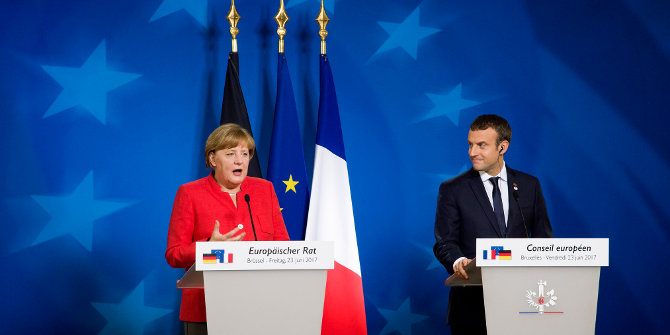 The latest UK unemployment figures showed unemployment at its lowest level since the 1970s, but there has also been a decline in real wages of 0.4% over the last year. Drawing on a new report by the Institute for Public Policy Research, Grace Blakeley explains that despite the headline figures on employment, the UK still faces a number of major economic challenges.
The latest UK unemployment figures showed unemployment at its lowest level since the 1970s, but there has also been a decline in real wages of 0.4% over the last year. Drawing on a new report by the Institute for Public Policy Research, Grace Blakeley explains that despite the headline figures on employment, the UK still faces a number of major economic challenges.
As the UK negotiates to leave the European Union, the government has made much of the strength of our economy and our competitive advantage with relation to our major trading partners. Our growth and employment rates do not appear to have been damaged by the vote to leave the EU, and many businesses have been quick to identify the potential opportunities associated with an independent approach to global trade.
But despite strong growth rates in 2016, the UK is not expected to experience GDP growth as strong as that anticipated in Europe and the US over the next several years. Our predicted growth rates of 1.6% in 2017 and 1% in 2018 are dwarfed by an anticipated 2.1-2.4% for the US and 2% in Germany. Part of this can be put down to the uncertainties of Brexit. But slowing growth rates are also partly driven by long-standing structural issues in the UK economy.
In fact, as the Interim Report of the IPPR Commission on Economic Justice highlights, on a whole host of issues – from wages to productivity investment to trade – the UK’s economy lags behind its major competitors.
The government likes to boast that the UK has recently achieved record levels of employment. But this has been accompanied by the growing insecurity of the labour market. Surveys suggest that as much as 8% of the workforce is now under-employed – that is, wanting to work more hours than they do. The number of people on zero hours contracts has increased more than five-fold since 2007, to more than 900,000. Self-employment has increased from 13% of the workforce in 2008 to 15% today, yet self-employed people earn less on average than they did 20 years ago. This insecurity is linked to the ‘flexibility’ of our labour market, which is ranked 8th of 140 in the World Economic Forum’s rankings, achieving the same score as the United States.
Normally, economists would expect high levels of employment to lead to increases in average real wages. But the reverse has happened. Indeed, the decline in UK real wages since the financial crisis has been the largest of all developed countries apart from Greece, Mexico, and Portugal. Between 2007 and 2016, annual real wages grew 10.8% in Germany, 9.5% in France and 6.4% on average across the countries of the OECD. In the UK, however, they fell by 2.6%. If inflation continues to erode nominal wages for the next four years, as projected by Office for Budget Responsibility, the period since 2007 will rank as the longest period of earnings stagnation since the 1860s.
The low-pay, insecure labour market that exists in the UK is partly responsible for our poor performance on productivity. Measured by output per hour, productivity in the UK is 13% below the G7 average, and productivity growth has more or less completely stalled in the last decade. The disparity between the UK’s productivity and those of our major competitors is sometimes expressed in the form ‘it takes the average British worker five days to produce what a worker in Germany, France, or the US produces in four’. But of course this is nothing to do with how hard people work: it arises from the much lower levels of investment in physical and human capital in the UK. Public and private investment is around 17% of GDP in the UK, more than 5% below the OECD average.
Corporate investment in the UK is much lower than in most of our major competitors. Corporate investment in fixed assets (not including construction) fell from 11% of GDP in 1997 to just 8% in 2014, compared with (for example) 12% in the USA. This is much lower than the rate of depreciation, meaning that the stock of capital in the UK is actually declining. This disparity is partly accounted for by the lower share of manufacturing in the UK economy, but is still lower even when this is taken into account. And it is especially reflected in the lower share of research and development investment, which is of particular concern given the importance of innovation in driving future growth.
The sectoral make-up of the UK’s economy has also led to the emergence of a large current account deficit: our trade deficit has exceeded 2% of GDP for 15 of the last 16 years. This is at least partly due to the decline of our manufacturing base, which, though familiar to most of the developed world, has been far more acute in the UK than in competitors such as Germany and France. The depreciation of the pound which followed the EU referendum has helped to raise exports somewhat – but not by as much as might have been expected, because the UK is particularly reliant on a small number of exporting sectors (of which financial services is much the largest) and many exports are made up of imported components. The UK’s trade performance is a consistent indicator of the weakness of UK productivity and competitiveness.
As such, it is hard to accept the government’s view that the UK economy is in a strong position to cope with the challenges of Brexit. Underneath the headline figures it is actually much weaker than most of our major European competitors. And Brexit will make many of these weaknesses more difficult to address. That is why the IPPR Commission on Economic Justice is calling for a fundamental rethink of economic policy in the UK. The first step is to acknowledge that we have a problem.
Please read our comments policy before commenting.
Note: The full report on which the above draws is available here. This article gives the views of the author, not the position of EUROPP – European Politics and Policy or the London School of Economics. Featured image credit: Pixabay/Public Domain
_________________________________
 Grace Blakeley – IPPR
Grace Blakeley – IPPR
Grace Blakeley is a Researcher at IPPR.





